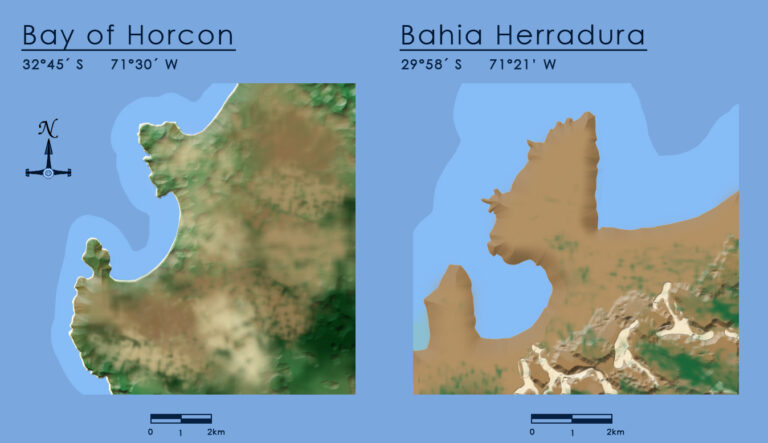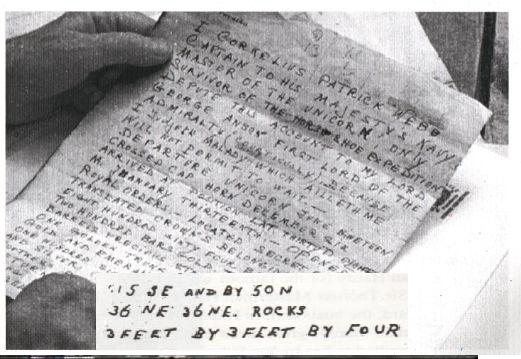Re-activation of the hoax
After World War Two, Wilkins attempted to re-activate the hoax riddle but this time he changed direction to make the pointers head directly towards Juan Fernandez Island. This was done by planting another hoax riddle on an unsuspecting treasure hunter in Chile named Luis Cousino.
Luis Cousino came from a rich family who had made their fortune through mining interests. You might see the formative link about how this was achieved in that most of those identified as being involved in this hoax/riddle were mining engineers.
According to story as told today it all began around 1950 with the arrival on Juan Fernandez Island of an Italian, Jorge di Giorgio, on his yacht. Later anecdotes about him , eg. all night poker games, charges of smuggling, cheap tricks, suggests he was some type of grifter living on his wits. Giorgio learned the legend of the island’s treasure (Lord Anson’s Treasure) and decided to find out more about it by contacting a Chilean friend, now living in England. This was the beautiful Tita Diaz, who years before had married Sir Archibald Clark Kerr, Great Britain’s Ambassador to Chile. After exhausting all inquiries to the Admiralty about Lord Anson, and on the insistence of Giorgio, she visited the castle that was Anson’s home. In an old writing desk were some letters written in cipher that she sent to Giorgio. Giorgio couldn’t understand what was written on the letters but his mother, Angelica Lyon, was an expert in cryptograms and puzzles. One of the documents was said to show the ‘Bay of Pascoy’. Armed with this information Di Giorgio traveled by land and sea along the coast of Chile in search of ‘Pascoy’ bay. He came to the conclusion that this was the bay of Horcon, to the north of Quintero. As Di Giorgio had no money to fund an enterprise to recover the treasure, he approached Luis Cousino who was both his friend and a man of fortune.
Cousino, under cover of darkness, began to search the beaches of Horcon. Guided by the old map, Cousino managed to locate a box buried there containing a letter written in the same code as the other documents from England. This was said to be Webb’s letter to Lord George Anson.
Luis Cousino, Jorge di Giorgio, Richard Lyon and Peter Scott formed a secret society to organize a treasure expedition to Juan Fernandez Island. Cousino was to finance this expedition receiving in turn 52% of the find with the remaining 48% (or 16% each) going to the other three.
Cousino, his wife and young son Matias went over to Juan Fernandez. Through a family contact in Lota coal miners were engaged to excavate the treasure. The first task for them was to determine the meaning of the directions in the Webb report. What was the exact altitude of the star Schuba in the constellation Scorpio for the year 1761? This was a complex task. Scotti and Cousino, who had been astronomers, worked on this task aided by advice received from several universities. The place to excavate was determined by a line passing through the angle of Schuba, a yellow stone and the ‘Observation Point’ taken to be one of the navigational monoliths placed on Juan Fernandez Island (*no, it doesn’t make any sense but that is what the story says). The location today is in a place called the Calle La Polvora which is in the town of San Bautista.
The excavations reached a depth of thirty feet and were extended with lateral galleries. No treasure was found. Di Giorgio himself took no part in the excavations.
You need to remember that in 1948, Wilkins had published ‘A Modern Treasure Hunter’. In that Westhaver had said he had found a buried box containing documents which led to the ‘subterranean cavity’. Wilkins even added the comment, “It suggests to me (the joint author of this book) that the island was, one time o’day, a regular munitioning base and rendezvous for a pirate admiral of the older buccaneering type of Sir Henry Morgan or Barty Sharp.”
It can only be said again that the clues Wilkins gave in this book, being written in English, were not intended for the native Spanish speakers of Chile.
Wilkins added a footnote in regards to Westhaver that is worth remembering,
“According to Westhaver the “right person” has to furnish, as credentials, a peculiar or symbolical picture which dovetails, like and old fashioned apprentices’ indenture, into another portion of a document relating to this mysterious treasure island, said document being held by Mr Westhaver.”
He was referring to adding Ubilla’s map and to Lord George Anson’s monument.
The real events
The name given in the Anson file for Webb’s mission was the ‘Horseshoe Expedition’ and there is also the detail given in Webb’s report which says,
“ arrived at the position Latitude thirty D(egrees) and eight M(inutes) on the thirteenth of January”

The image on the left shows the bay at Horcon where Cousino was supposed to have searched and found the box. The image on the right shows the Guayacan coastline which includes Bahia Herradura (Horseshoe Bay).
You can immediately see that the bay at Horcon is very similar in shape to Horseshoe Bay.
There is nothing expressed in the documents you have already read which suggests a geographic shape for the correct location other than the word ‘Horseshoe’ in ‘Horseshoe Expedition’. Nevertheless, the map for ‘Pascoy Bay’ was being interpreted by Cousino to be showing a horseshoe shaped bay.
The timeline for the story reveals that it was not until after Cousińo obtained the Webb report that they went to search Juan Fernandez Island and this was after his search of Horcón. As the story about obtaining the Anson file via Tita Diaz was false, they had to be searching Horcón for some other reason. The reason is quite simple when you know all the players pulling the strings behind the scenes.
If you haven’t figured it out yet Cousińo and Co. were just common treasure hunters. They were searching Horcón because it was similar in geography to Guayacan where a local treasure legend said a fabulous treasure had been hidden somewhere in Horseshoe Bay (Bahia Herradura). You will notice the words ‘Horseshoe’ and ‘Rose’, from that story were also to be found appearing in the Webb report. Detailed maps, written directions and even an inventory existed for the Guayacan treasure, all of which were found in one referential book titled ‘El Tesoro de Los Piratas de Guayacan’.
Of course as part of your research you would probably go and speak to the expert on the matter who wrote that book, Richard Latcham. This meant that Cousino and Co. had been in contact with Latcham prior to 1943 as Latcham died that year.
The backstory about finding these documents in England and in a box on a beach is just a flimsy cover. If you do some probing research you will find the report how around 1950 Cousino was fortuitously contacted by an ‘Englishman’ who had obtained the Webb report and Lord George Anson’s file from a ‘museum in London’.
This report inferred their search should be on Juan Fernandez Island as it said “transferred to new hiding place valley of Anson”. Cousino took this to be a reference to Cumberland Bay.
Wilkins just used them as mules, mere carriers of the clues. How concerned he was that they would wake up to what was happening is shown by the Webb report he gave them being in the same handwriting as on the Captain Kidd hoax maps. It was never intended that Cousino would ever be able to understand the clues either as the story about him finding the box on Horcón beach shows. As a convenient cover story to explain the appearance of the documents it would mean little to him but it is a rather obvious clue to someone following the trail Wilkins was leaving.
Unfortunately no one followed the clues (again).
But by the 1950s, the world was vastly different to the one prior to World War Two. The vast changes in society and government after the turmoil of the war meant the age of Kings and Royal Families had truly passed. The map of Europe had been changed forever. The adventure of seeking out ‘lost treasure’ in remote and forgotten lands had been extinguished as the world had become smaller. ‘Pirate Treasure’ was of no interest anymore. The new concern for everyone was the rise of Communism and the impending atomic war.
Who was interested anymore in the riddle of the location of some furniture from the Temple of Jerusalem that would certify your claim of sovereignty to Kingdoms that no longer even existed?
Harold T Wilkins consigned the ‘Captain Kidd’s Treasure Charts’ hoax to history; he did no more active work on it.
That is not to say the whole thing was consigned to history.
Planted for posterity in the 1950s was the final part of the answer to the mystery, again in the form of a hoax riddle; the mystery of the lost treasure of Rennes le Chateau.



